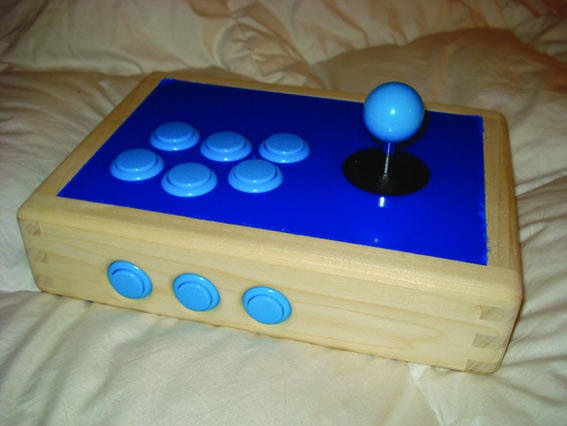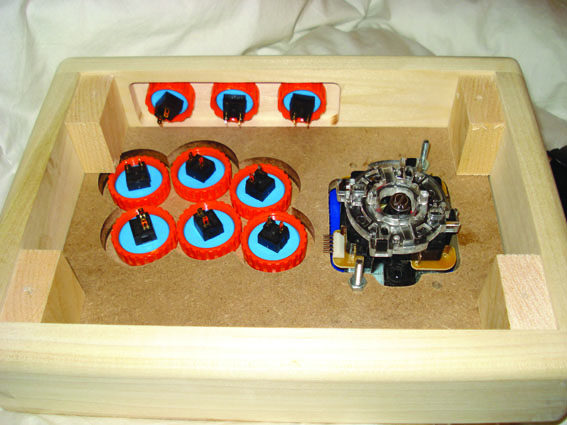This past June I purchased my first wood router a 9.5A Fixed base Mastercraft with table. I understood the basics of how it worked but it still took a lot of trial and error, wasted pieces and trips to the Hardware Store before finally found my groove. So, instead of letting others flounder as I did I have decided to share what I have learned and hope others more skilled than me will lend a hand as well.
After completing almost 100 controller cases over the past few months (sorry, I am not allowed to sell them on this site yet) I have learned the following:
Safety:
FIRST AID ? Never, I mean never, work in the shop without having a first aid kit and fire extinguisher handy. If working alone, also have a phone nearby in case of emergency.
EYES - Always wear eye protection. Glasses are certainly better than nothing but I find that saw dust is a far bigger problem than wood chips, buy goggles instead.
EARS - Buy muffs, not plugs. You are going to be putting them on and taking them off a lot and ear plugs will just get dirty all the time and probably end up giving you a headache.
RESPIRATOR ? A lot of people cheep out here but I implore you not to. Those little white masks are all but useless against fine MDF dust and trust me, you do not want that stuff in your lungs. Buy a proper mask. Sure, it cost more but you will have it for life so think of it as an investment.
CLOTHING ? It goes without saying (I hope) that you should never wear loose fitting clothing that might get caught on something, avoid long sleeves, wear proper shoes, etc.
VENTIATION: Always work in a well ventilated area with adequate lighting.
The Router:
Routers are one of those odd exceptions where bigger does not always mean better. Unless you plan on making wood cabinets, which require larger bits and thus a more powerful motor, save some money and get sub 3-hp model.
Plunge vs Fixed-Base ? Which to buy really depends on what you plan to use it for. If you only plan on buying one I suggest going with a fixed base that can be use free hand or bolted to a table if necessary.
Maintenance ? Many routers have motor brushes (check your manual). If yours has them, that is fine but you need to realize that they can and do wear out rather quickly and must be replaced. Of course, no one actually stocks parts for the tools they sell so you will probably have to order them from the manufacture. My advice is to order some spares so you will have them on hand when needed.
Grease ? If you find that your router is not spinning as freely as it used it might be time to grease it up a little. The spinning part under the collet can get clogged up after a while, I much prefer grease but unless you feel like taking your router apart WD-40 or some similar product should do the trick.
Dust ? Dust really will not hurt your router (accept for the above) but it can make a terrible mess. If you router has dust attachment use them in conjunction with a Shop Vac. If cutting MDF also get some dry wall dust bags. MDF dust will go right through most filters.
Wear and tear ? When is a router being worked the hardest, under load or freely spinning? Many of you probably said under load but you would be wrong. A router is designed to be under load, it is when it is just spinning away that the brushes really get worn down. Turn it off between cuts, or better yet use a foot operated power switch. This also makes for an excellent kill switch if something goes wrong.
Consumer model vs Professional - Professional models are made to handle more abuse but the main difference has to do with the motor wrappings. Professional models tend to wrapped with copper while consumer models may be wrapped with aluminum. Copper conductors are more efficient and provide more power but copper also weights more and is more expensive.
BITS:
Bit Size ? If you look at bits in the store you will probably notice two different sizes of bit shank (shaft), 1/4’? and ?. If possible buy a router that will accept both. If you have to choose one or your router will handle both always get the ? bits. The larger shank will reduce wobble and friction in the router collet and will dissipate heat more quickly
Bit Types ? Most quality bits are now carbide-tipped and that is what you want. They will last a lot longer than HSS (high-speed steel) and have a hardness approaching that of diamond. What will break a carbide tip? Another carbide tip will do nicely. Do yourself a favor and store your bits safely and separately.
Bit Cleaning ? MDF and Pine are your enemy. If you start to see a bunch of gunk forming on your bit (which sadly will not take very long) clean the bit with a resin remover. If you don?t you will soon find that your bit has to work a lot harder to make the cut, it will not be as smooth and you greatly increase the risk of burning the wood.
Remove any pilots before cleaning. Resin remover will remove oil as well which is not a good thing for a pilot bearing.
Advice:
Kickback ? If you try to feed too quickly you may experience kickback. Try not to panic and let go of the piece unless there is a real danger that you may touch the bit. A loose piece of wood can do all sorts of not so wonderful things rubbing up against a spinning router bit. This is where a foot operated kill switch comes in really handy.
Cutting ? Do not try to cut out too much all at once. Make several passes with increasing depth.
Tear-out ? If possible use a backing board to minimize tear-out. Several passing of increasing depth will also help minimize this.
A good table is worth its weight in gold, jigs and templates are great but a router really comes into its own with a table. If you don?t want to buy one you may want to consider making one as one of your first projects. Quality plans can be found on a number of sites.
Here is shot of my first completed box, minus artwork and varnish.


Hope this helps
Nathan